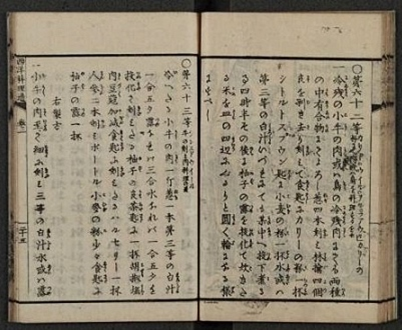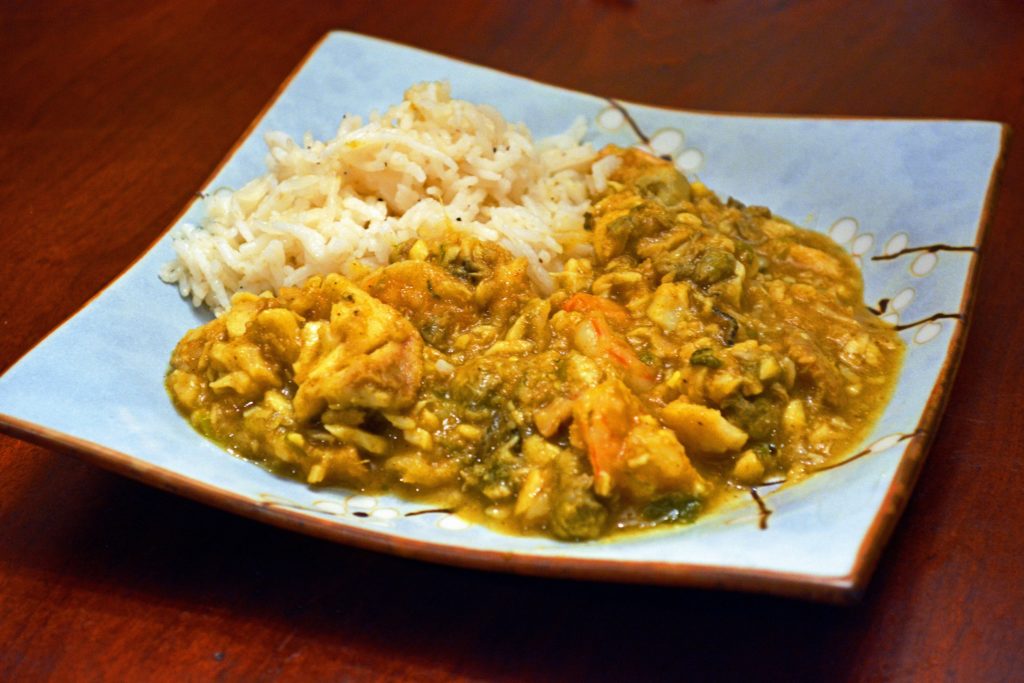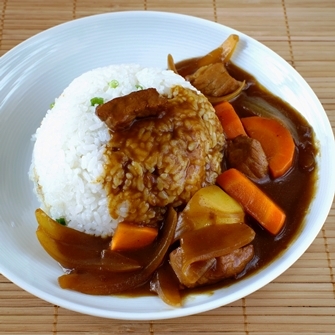The next stop on our exploration of Indian Curry Through Foreign Eyes is Japan. Curry came to Japan by way of British sailors and merchants in the mid-19th Century. This happened sometime after Commodore Matthew Perry landed at Kurihama in 1853, and opened Japan to the world after centuries of isolation. The first recipe for curry in Japanese was published in 1872 by the renowned writer and satirist, Kanagaki Robun, in his Western Food Handbook or Seiyo Ryoritsu. The recipe is for a mixed-seafood curry with large quantities of fresh ginger and a little butter, salt, and curry powder.

Curry took Tokyo by storm in 1927 when the Hankyu Market Restaurant started to serve curry. Demand for curry dishes was so high that a direct farm-to-table supply of ingredients was secured to feed the 25,000 customers a day (65,000 a day on Sundays) who ordered curries. The modern age of curry was ushered in 1950 when Bell Foods started selling curry powder mixed with flour in a chocolate-bar form, now called curry-roux. All home-cooks needed to do now was to break off a few squares of spice and add them to whatever they wanted to “curry”.
Concomitant with its increasing popularity in the general public, curry rice and other curry dishes also became mainstay meals in the Japanese military. In addition to feeding the troops in the field and at mess, this also allowed conscripts from all over Japan to experience curry – facilitating its further acceptance.
From its humble beginnings in 1872, curry has become one of the most popular of Japanese dishes. Over the years, curry has been adapted to Japanese tastes and cooking methods, and today there are over 80 different kinds of Japanese curry, from curried rice, and curried udon or soba noodles, to bread with curry sauce or kare pan, and tonkatsu cutlet curries. Press surveys report that the ‘average’ Japanese person eats curry 84 times a year – or more than once a week.
Today’s Japanese curry has little in common with its Indian ancestor. It is almost uniformly sweeter than any Indian curry I’ve had, and often has apples and honey added to it to tame the sharp edges of the spices in the curry–roux mix. In general, there also seems to be a lot more sauce in Japanese curries than in Indian ones. There are also special dishes representative of the areas they come from, like Sika-Deer Curry from Hokkaido and Natto Curry from Ibaraki Prefecture.
What strikes me as very strange is, if curry is so popular in Japan, why is it so under-represented in Japanese restaurants in the west? We have a few large Eastern Asian markets in our area that have food courts, and some of the food stalls serve a couple of Japanese curry dishes. Other than that, there is no Japanese restaurant from Baltimore to DC that has Japanese curry on its menu. Most offer sushi and the Japanese-American food-theatre known as hibatchi (which is really teppanyaki-style cooking). Although I haven’t done a thorough survey of Japanese restaurants in the US, I suspect that Japanese curry is difficult to find on most menus.
So, on to the first Japanese curry recipe.
The First Japanese Curry (1872)
Ingredients
1 raw cibol, finely-chopped (Allium fistulosum)
1/2 ginger race, minced
1 piece of garlic, finely-chopped
1 tablespoon butter
shrimp
oyster
sea bream
reddish-brown frog
1 teaspoon of curry powder
appropriate quantities of salt
2 tablespoon wheat flour, mixed with water
270 ml water
Directions
Heat butter in a pan and cook raw cibol, ginger, garlic 2. Add 270ml water, shrimp, sea bream, frog and boil 10-20 minutes 3. Add curry powder, salt and boil 1 hour 4. Add water-mixed flour and stir.
_____
There were several issues with the original recipe that required interpretation and/or revision. The first issue was deciding how much ginger was in a “race.” Luckily I got some assistance on that matter from Kathleen Wall of Plimoth Plantation who shared with me the amount considered a “race” by the cooks interpreting recipes at Plimouth. Half a race still seemed like a lot of ginger, but that is what I used. The next issue I had was that I needed to add more water than called for, because more moisture was needed to create a curry sauce from the spring onions, garlic and ginger. The next problem was what seemed like excessive cooking times for the fish. I opted to add the fish and shellfish after the curry sauce had been made and only cooked them for a few minutes. This is the method I generally use for modern curries with similar ingredients.
One thing that continues to vex me about trying to re-create this recipe is that to a large degree, a curry is made by the masala, the mix of dry spices used, or in the ingredients in the commercially prepared curry powder. In the original recipe, there is no information given about the make-up of the curry powder. I did some research, but had little luck finding information on what might have been used. Ultimately, I had to resort to a modern product and so chose the turmeric-laden S&B Oriental Curry Powder. If another product were used, say some break-off squares in a House Foods – Vermont Curry block, the taste would change according to the makeup of the product used.
Lastly, I had to omit the red frog. I simply didn’t know what species it might be, and didn’t want to take any chances. The resulting recipe follows:
First Japanese Curry (1872) (Interpreted)
Ingredients
1-2 tablespoons butter
1/2 ginger race (slightly more than 1/2 cup), peeled and grated
2 cloves garlic, finely-chopped
1 small bunch of spring onions (about 6 stalks), chopped
2 cups water
3-4 teaspoons of curry powder
1 teaspoon salt (or to taste)
1 – 1½ cups medium shrimp (10-12 shrimp), peeled and deveined
1 sea bream (porgy), cleaned and chopped
1 cup oysters, chopped
2 tablespoons wheat flour, mixed with water
Directions
Melt the butter in a medium saucepan and sauté the spring onions for about one minute over medium heat. Then add the ginger and garlic and sauté for 2-3 minutes or until they start to color. Add water and stir well until warm. Let cook for 3-5 minutes and add the curry powder and salt and stir well. Cook uncovered for 10-15 minutes over medium-low or low heat, stirring often until sauce begins to form.
Add fish and cook for 3 minutes, then add shrimp and oysters and cook for another 3-4 minutes until shrimp are pink and curled. As fish and shellfish are cooking, mix the flour and water together until smooth. When the mixture is smooth, stir it in a bit at a time to thicken the curry sauce. You may not need to use all of the mixture. Cook for a few minutes to banish the “raw” flavor of the thickening mixture. Remove from heat and serve with rice.

The taste of the curry is very good. Although very much influenced by the ratio of ingredients of the curry powder, the mingling of fish and shellfish flavor with the curry powder is delicious. There is also an interesting, almost buttery flavor to the curry, which is surprising given the modest amount of butter used in the recipe. Lastly the large amount of ginger used cooks down nicely and adds a light gingery taste to the curry without being bitter. The garlic and spring onion, while adding depth to the curry are undiscernible as individual ingredients.
The first Japanese curry also differs a great deal from modern Japanese curries, which come in several distinct commercial varieties. These range from “spicy” Java curry to sweet Vermont curry, with Torokeru and Kokumaru falling in between the other two. Golden curry is a muted, less distinct alternative than the other types. To complicate the situation, most Japanese curry cooks, both at home and in curry shops, blend the curry-roux blocks to make distinctive or signature flavors for those enjoying their dishes.
There seems to be a movement amongst younger Japanese cooks to try to make curries from “scratch” – by creating their own mix of spices. Sometimes these recipes are both good and interesting and offer a mix of standard curry spices. At other times, recipes simply add a lot of garam masala to the pot, replacing one commercial spice mix with another highly variable spice mix. Interestingly, almost all of these new recipes use some sort of roux (cooked tan or brown) with spices to thicken the dish instead of the white-wash or slurry of flour and water used in the first Japanese curry recipe.
There are also a wider variety of vegetables used today than in the first Japanese curry recipe. For example, a seafood curry recipe from the House Foods website has several yellow onions in it, some white wine and uses a Kokumaru curry-roux block. Other recipes I’ve seen include a mix of vegetables, such as zucchini and eggplant in addition to the onions, still other add potatoes or carrots. So you see, even though a commercial spice mix is at the heart of modern Japanese curries, there is a lot of variation still to be experienced in the dishes, with the results depending upon the imagination of the individual cook.
(Words, recipe interpretation and cooking by Laura Kelley. Photo of Seiyo Ryoritsu text taken from a PDF of the manuscript by Laura Kelley, photo of Bon Curry advertisement borrowed from the Kikkoman website, photo of Japanese Curry Rice by Torsakarin@Dreamstime.com, and photo of The First Japanese Curry by Laura Kelley. Special thanks to Mr. Hiroo Watai who found the first Japanese curry recipe for me and translated it.)

